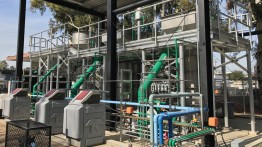Sebastien Tilmans

Sebastien Tilmans CE’07
Most of the world’s wastewater reaches the environment with no treatment at all, causing death, disease, and environmental devastation. As the US Southwest endures its worst drought in 1,200 years, wastewater can help alleviate growing water stress around the world. But traditional wastewater treatment is expensive and a major energy consumer. Sebastien Tilmans the executive director of the Codiga Resource Recovery Center at Stanford University, a facility to accelerate development of technologies to tackle these challenges. Thousands of gallons of campus wastewater are pumped through several stages of treatment for testing, then delivered back to the sewer system. The Codiga Center gives undergraduates, graduate students, and post-docs—whom Tilmans refers to as “tomorrow’s water leaders”—a place to test innovations and gain practical experience. Researchers learn the “nuts and bolts of what it takes to assemble, maintain and operate a wastewater treatment plant from fabrication to troubleshooting pumps to calibrating instruments and to unclogging things when they get clogged.”
Tilmans, who spent three years in Panama designing and implementing decentralized anaerobic wastewater treatment systems, is scaling up one of the Codiga Center’s most promising technologies to a full-scale utility in collaboration with Silicon Valley Clean Water. The Staged Anaerobic Fluidized-bed Membrane Bioreactor is a transformative system that not only cleans water to US standards but produces surplus renewable energy that could be fed into the power grid. The next step is to demonstrate achievement of quality for non-potable and even potable water reuse, said Tilmans, who was a Fulbright scholar as well as the recipient of the Henry D. Dickinson Award for Highest GPA in Engineering at The Cooper Union.
“So [we’re] not just thinking about how to get clean, potable water but also how do we really transform the paradigm to be producing clean, renewable energy at the same time.”




